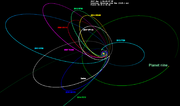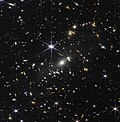The Outer Solar System Origins Survey (OSSOS) is an astronomical survey and observing program aimed at discovering and tracking trans-Neptunian objects...
28 KB (1,960 words) - 08:15, 3 December 2023
Extreme trans-Neptunian object (category Solar System)
orbit is influenced by the galactic tide and other stars. The Outer Solar System Origins Survey has discovered more extreme trans-Neptunian objects, including:...
30 KB (2,333 words) - 18:22, 14 August 2024
the outermost regions of the Solar System. It was discovered on 9 September 2015, by the Outer Solar System Origins Survey at Mauna Kea Observatories on...
16 KB (1,064 words) - 03:07, 8 February 2024
The Solar System is the gravitationally bound system of the Sun and the objects that orbit it. It formed about 4.6 billion years ago when a dense region...
222 KB (21,885 words) - 00:25, 4 November 2024
in the Kuiper belt of the outermost Solar System. It was first observed by the Outer Solar System Origins Survey using the Canada–France–Hawaii Telescope...
6 KB (432 words) - 07:17, 31 July 2024
There is evidence that the formation of the Solar System began about 4.6 billion years ago with the gravitational collapse of a small part of a giant molecular...
113 KB (13,496 words) - 07:25, 2 November 2024
the Solar System, approximately 102 kilometers (63 miles) in diameter. It was first observed on 24 May 2015, by astronomers of the Outer Solar System Origins...
7 KB (398 words) - 12:59, 2 February 2024
was first observed on 8 September 2015, by astronomers with Outer Solar System Origins Survey using the 3.6-meter Canada–France–Hawaii Telescope at Mauna...
9 KB (597 words) - 21:34, 14 January 2024
its OSSOS survey designation uo3L91, is a trans-Neptunian object discovered on September 29, 2013 by the Outer Solar System Origins Survey using the...
12 KB (917 words) - 07:54, 26 March 2024
of the Solar System, approximately 117 kilometers in diameter. It was first observed by astronomers during the Outer Solar System Origins Survey at the...
5 KB (314 words) - 21:03, 27 November 2023
a member of the Canada–France Ecliptic Plane Survey (CFEPS), and the Outer Solar System Origins Survey (OSSOS) which has detected and tracked the world's...
8 KB (416 words) - 04:14, 3 March 2024
A hypothetical Solar System object is a planet, natural satellite, subsatellite or similar body in the Solar System whose existence is not known, but has...
20 KB (2,278 words) - 12:47, 12 September 2024
first observed on 22 October 2014, by astronomers with the Outer Solar System Origins Survey at the Mauna Kea Observatories, Hawaii, and was provisionally...
8 KB (537 words) - 08:21, 6 January 2023
is a list of most likely gravitationally rounded objects (GRO) of the Solar System, which are objects that have a rounded, ellipsoidal shape due to their...
127 KB (6,193 words) - 20:18, 24 October 2024
This article includes a list of the most massive known objects of the Solar System and partial lists of smaller objects by observed mean radius. These lists...
251 KB (10,721 words) - 20:35, 6 November 2024
Planet Nine (redirect from Solar Planet Nine)
Planet Nine is a hypothetical ninth planet in the outer region of the Solar System. Its gravitational effects could explain the peculiar clustering of...
176 KB (18,915 words) - 22:23, 5 November 2024
the Solar System, approximately 100 kilometers (60 miles) in diameter. It was first observed on 21 May 2015 by astronomers with the Outer Solar System Origins...
8 KB (504 words) - 18:02, 27 November 2023
outermost region of the Solar System. It was discovered on 5 August 2013, by astronomer with the Outer Solar System Origins Survey at the Mauna Kea Observatories...
9 KB (558 words) - 19:21, 27 November 2023
Asteroid belt (redirect from Outer Main-belt Asteroid)
The asteroid belt is a torus-shaped region in the Solar System, centered on the Sun and roughly spanning the space between the orbits of the planets Jupiter...
83 KB (8,794 words) - 06:48, 25 October 2024
the Solar System, approximately 260 kilometers (160 miles) in diameter. It was discovered on 2 August 2013, by astronomers of the Outer Solar System Origins...
8 KB (469 words) - 19:22, 27 November 2023
of the Solar System, approximately 78 kilometers in diameter. It was discovered on 9 September 2015, by the Outer Solar System Origins Survey using the...
5 KB (245 words) - 21:02, 27 November 2023
of the Solar System, approximately 212 kilometers in diameter. It was discovered on 8 February 2013, by the Outer Solar System Origins Survey at the Mauna...
6 KB (416 words) - 19:22, 27 November 2023
Solar System bodies have orbits with only slight inclinations to the ecliptic, using it as the fundamental plane is convenient. The system's origin can...
14 KB (1,331 words) - 17:44, 18 April 2024
forming hypotheses concerning the origins of the Solar System and the Moon and attempting to predict how the Solar System would change in the future. René...
63 KB (8,744 words) - 18:18, 24 September 2024
the outer border of the Solar System. The distance to the heliopause is not precisely known and probably depends on the current velocity of the solar wind...
55 KB (6,597 words) - 19:10, 21 October 2024
2013 VZ70 (category Centaurs (small Solar System bodies))
with Saturn. It was first observed on 1 November 2013 by the Outer Solar System Origins Survey at Mauna Kea Observatory in Hawaii, United States. The discovery...
7 KB (446 words) - 19:26, 12 September 2023
Sun (redirect from Solar diameter)
The Sun is the star at the center of the Solar System. It is a massive, nearly perfect sphere of hot plasma, heated to incandescence by nuclear fusion...
165 KB (18,120 words) - 05:41, 2 November 2024
team. In 2014 she was co-investigator on the COLours for the Outer Solar System Origins Survey (OSSOS). She was appointed a postdoctoral fellow at the University...
17 KB (1,400 words) - 07:09, 25 February 2024
In planetary astronomy, a centaur is a small Solar System body that orbits the Sun between Jupiter and Neptune and crosses the orbits of one or more of...
43 KB (4,573 words) - 02:55, 31 October 2024
uncrewed spacecraft have reached all of the known planets in the Solar System. Outer space represents a challenging environment for human exploration...
138 KB (13,570 words) - 05:55, 5 November 2024
















